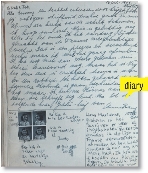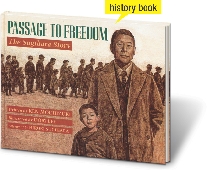How We Learn About the Past
Vocabulary: Historical Records
Language: Make Comparisons
We call the early 1940s “The War Years” because the U.S. fought in World War II from 1941–1945. Here are some ways you can learn about the 1940s.

Some people wrote about their lives in diaries or journals. You can read them to see what people’s lives were like in the past.
diary

You can read old newspapers. They reported the daily events as they happened. Photographs made the news come alive.
newspaper
photograph

Look in books written later by historians. A historian reads many sources and tells the story of the past.
history book
Oral Language Practice
MAKE COMPARISONS
1.–3. Who’s talking? ![]()
Listen. Three students are talking about their research. Which record of history is each student talking about? Point to the correct picture. Then work with a partner. Compare two of the records shown above. Take turns naming similarities and differences.
Written Practice 
4.–6. Write 3 comparisons. In each, compare 2 other kinds of records, like movies or magazines. Use words from the box.
4. A magazine and a movie both give us information. A magazine tells about the past with words and pictures, but a movie shows action with pictures that move.